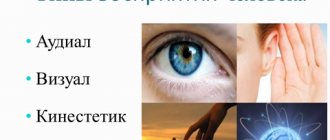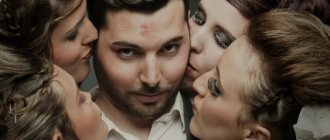A person perceives information through the main five channels: visual, auditory, tactile, gustatory, olfactory. And after perception, the information is processed in our head, and the interesting thing is that it is processed on the basis of one prevailing system .
There are four main types of sensory systems:
- Visual. When the visual information processing system is dominant: shape, location, color.
- Auditory. The auditory information processing system is dominant: sounds, melodies, their tone, volume, timbre, purity
- Kinesthetic. Sensory information is dominant: touch, taste, smell, sensation of textures, temperature
- Digital. Associated with the logical construction of internal dialogue.
One should not think that the dominance of one means the weakness of the other. It’s just that one of the systems is most often the starting, leading one. It is the leading system that launches the thinking process and becomes the impetus for other mental processes: memory, representation, imagination.
How can you determine who you are: visual, auditory, kinaesthetic or digital by speech?
Carefully monitor your speech and write down exactly the phrases that you use to indicate your opinion and your actions. Most often, a person of a particular type of perception uses phrases characteristic of this modality.
Visual
Uses words and phrases related to visual actions : I didn't see, I saw, I noticed, I think it was colorful and great, it looks, focus is concentrated, contrast, perspective, you see.
Audial
They often use phrases with auditory phrases : I can’t understand what you’re saying; didn't hear; I heard it; I recently heard; glad to hear from you; I heard it; the idea sounds tempting.
Kinesthetic
This type of perception is characterized by phrases that show their emotional and bodily responses: I can’t stand it; it's disgusting; it is so sweet; goosebumps; so pleasantly warm; it was a powerful experience. Often their nonverbal signs are very indicative; facial expressions and gestures are telling and reflect the state and emotions of a person, even if there are not many nonverbal signs themselves.
Digital
Digitals pay attention to logic and connections. A specific set of words is not typical for them: phrases of auditory and kinesthetic types may appear. Digital people often ask: what is the point of this; I don’t understand how this is connected; I would like to bring everything into a system; we need to streamline this somehow. However, such expressions are typical of most types with a good sense of organization. Therefore, identifying digital from speech must be done with great care.
Each type has its own characteristics that affect its perception of surrounding information, any educational processes, and interaction with other people. Let us analyze the characteristics of people of different types of perception.
Who is a visual person?
A visual person is a person with an extremely active visual-associative function of the brain, i.e. those who perceive the world through visual images literally feel reality with their eyes. The eyes are the dominant sensory organ of such a person , and therefore all other visual senses are not so acutely developed, although they also participate in processing information entering the brain, but not to such a significant extent as the eyes.
The characteristic and most noticeable features of a visual person include developed facial expressions, which are especially activated when he tries to remember something - the reality of such a person is represented by many pictures, they are constantly scrolling in his brain. It is living facial expressions that are called the most striking external feature of this psychological type.
Fixing a visual image in memory, its color, shape, order of numbers or pages of text, is the best way for a visual learner to remember information. At the same time, one more important fact should be noted - in terms of knowledge of the surrounding world, visualists are the most common psychotype, since a person receives almost 90% of the information about what is happening around him thanks to vision.
The concept of “REPRESENTATIVE SYSTEM”
When interacting with the world around us, we receive information about it through sensory channels (representational systems) - visual, auditory, kinesthetic and discrete (logical).
A science such as NLP (neurolinguistic programming), by studying oculomotor reactions (trajectory of movement of a person’s eyeballs), analyzing speech predicates, coupled with the study of his postures and gestures, very effectively determines the leading representative system of a person.
Recommended on the topic: You don’t owe anyone anything. Except for yourself... Is this so? Components of the Self
This is the dominant sensory channel through which information about the environment enters the human brain.
External signs of the visual
A visual person almost always operates on an external, visual image, trying to transform his oral speech into a picture. Representatives of this psychotype have excellent visual memory; in addition to it, the characteristic external signs of a visualist are:
- A speech rich in external images and numerous comparisons, in which the appearance and clothing of the interlocutor, the environment, the weather outside the window, etc. are vividly and in detail described, but other important points are often lost sight of, for example, the very essence of the conversation that took place, the result business meeting, etc.;
- When talking, the visual will try to position itself opposite the interlocutor in order to be able to constantly observe him, look him in the eyes, and at the same time examine the interiors and surroundings;
- Prefers spectacular and bright, but often not very comfortable clothes. However, visual artists carefully check each of their images , trying to fit harmoniously into the reality around them, while simultaneously emphasizing their own strengths and masking figure flaws;
- The speech of a visual person is filled with words and phrases such as “you should have seen”, “look”, “we can consider this obvious.” Such turns of speech help them better reproduce and describe the picture that has arisen in their head;
- Such individuals do not like telephone conversations , because they quickly lose the thread of the conversation without the image of the interlocutor in sight. When communicating on the Internet, a visual person will always prefer a webcam to regular text messages;
- They perfectly remember people's appearance, clothes and faces, but often cannot remember their names or other important information about a particular person;
- They do not like to come too close to the people around them, preferring to communicate at a distance of a meter or more. Thus, the visual not only does not invade someone else’s personal space, but also receives a more favorable viewing angle of the interlocutor;
- The visual gaze is not able to linger for a long time on a specific person or object; it is in constant search of new visual information;
- Having heard or read a text describing the beauties of nature or some interesting or unusual situation, the visualist will very vividly and plausibly imagine all this visually , without even wanting to;
- When equipping his own workplace, he gives preference not to comfort and functionality, but to beauty and external aesthetics . Will not refuse to sit by the window, but only if there is a beautiful view.
Visual, auditory, kinesthetic, digital in the learning process
If you study a lot, go to courses, trainings, read, then understanding your own type of perception will help you organize your own learning process with maximum benefit.
Visuals
The basis of their learning is visual information. For visual people, hearing and vision form a single whole, therefore, if such a person only heard the material (but did not see), then with a high degree of probability the information will be quickly forgotten. Visual learners instantly absorb all visual information, so it is most beneficial to use all methods and techniques for visually presenting the material:
- mind maps
- scheme
- graphs
- illustrations
- photos
- demonstration models
- experiments, experiments
Visual learners learn best through visual examples, where they see the material they are learning in real time. Primary memory is visual. They remember well the location of objects, paths, roads, and are well oriented in space. Some noise is not critical for a visual learner; he can concentrate in an environment of some noise and successfully study the material.
Visual learners perceive text information well and are able to quickly learn speed reading.
Audial
Uses the auditory perception channel as a trigger. Inner speech is moderately developed. They perceive lectures, music, conversations, and dialogues well. They clearly and effectively maintain the line of conversation and conversation; often it is during the conversation that they grasp the meaning of the material being studied. Silence is necessary when concentrating. If you are an auditory learner, then be sure to listen to lecture material and audio courses. Learn together with others, discussing the topic being studied, thinking out loud about the problem.
Kinesthetic
Receives information through actions and movements. He remembers any actions and practical exercises well. He perceives all information best through practical exercises and experiments, where he tests the information received with his own hands in practice. Information of a practical nature is especially well perceived: what moves and how, where to click.
It is important for kinaesthetic learners to feel, touch, smell, taste and fully experience the subject being studied. People of this type are very active, love and enjoy working. And they don’t like inaction. It is for kinesthetic learners that the saying “Movement is life” has a special meaning. It is very difficult for kinaesthetic people to maintain focus, they are easily distracted, it is difficult for them to sit still for a long time, or to do routine work.
Digital
They are well trained in all sciences that have strict logic and consistency: mathematics, physics, mechanics, technology. Such people often work in areas where there is a lot of research, mathematical and static processing, and programming. The main thing for digital is to understand the logic and connections in the material, to organize what is being studied into a system with clear cause-and-effect relationships. Therefore, during your studies, try to build the logic of the entire topic being studied. For this you can use:
- scheme
- mind maps
- compressed plans
- Personally compiled thesauri
Psychological portrait of a visual person
Often a person’s appearance is deceptive, but almost no one manages to hide their own habits and temperament. Thus, the most noticeable character traits of a visualist include:
- Tendency to order and cleanliness. The apartment or house of such a person may even surprise strangers with its cleanliness bordering on sterility; all things in the visual’s home are laid out strictly in their designated places, and the slightest disorder is instantly eliminated.
- Extremely selective memory - such an individual will fill in the smallest details of a person's clothing and face, but may completely forget about what he said. Visual learners are often advised to write down what they hear or important information; such a habit can make their life much easier (for example, when going shopping, it would be a good idea to take with you a list of necessary products and things).
- They can find fault with various little things , especially gifts. Even an expensive and sophisticated item, but carelessly packaged, will not make the proper impression on the visual eye; on the contrary, it will awaken negative emotions in him. But a simple, but decorated and tastefully presented gift will cause in him a storm of undisguised joy from the aesthetic pleasure received.
- Ease of communication. People of this psychotype are distinguished by a fairly easy-going character, and therefore communication with them will not bring the slightest discomfort to the interlocutor.
What benefits can you get for yourself - the advantages of the type
Visual learners are often successful academically and professionally because they can:
remember large amounts of information, using visual memory (an invaluable quality if you need to prepare for a session or certification at work);
skillfully navigate the area, armed with a map or electronic application, they will not get lost even in an unfamiliar city, and will quickly find the desired object or organization;
are able to understand drawings, complex diagrams and diagrams;
if desired, thanks to their rich imagination, they can develop artistic skills and learn to draw well, because a visual person sees the world in artistic images;
Their aesthetic taste and impeccable appearance can be envied, so the visual is in the spotlight.
Professions suitable for visual people
One of the main conditions for a happy life is rightfully considered to be a favorite activity, for which a person has inclinations and abilities. Visuals are distinguished by excellent visual memory, as well as a rather specific and original manner of perceiving information; these qualities can be applied in various spheres of human life.
A visual artist can make an excellent artist, photographer, colorist, fashion designer, architect, designer, painter, costume designer and interior designer. Many visual people have a penchant for the humanities and are capable of becoming good specialists in the field of psychology and sociology; in addition, people belonging to the described psychotype make qualified and capable teachers and lecturers.
Work and profession
Visual people can try their hand at activities.
| Profession. | Why is it suitable for visual learners? |
| Architect. | Thanks to his exquisite taste and ability to understand complex diagrams and drawings, a specialist will be able to show his best side. |
| Fashion designer, stylist. | If a person knows how to see beauty and wants to create it himself, then he deserves to become a fashion designer. And for those who do not have enough skills and imagination to create their own clothing line, you can select ready-made sets while working as a stylist. |
| Colorist. | A very popular specialty for people with color vision. |
| Painter. | If you are a visual artist and don’t want to spend a lot of time on training, then you should try yourself as a painter, because not everyone can become a good painter. And in the future, after gaining experience, the painter can retrain as a decorator. |
| Animator. | The ability to imagine details and a well-developed imagination will help a visual artist become a cartoonist. |
| Photographer, designer of social network pages. | A visual photographer will be able to see beauty and capture moments in time. Nowadays, creating a “visual” for a social network page and designing an eternal feed on Instagram are in demand. |
| Technical specialties. | A visual person with a less developed sense of beauty can try to become a designer, technician or engineer; the ability to keep a large amount of information in his head and work with drawings will only benefit him. |
| Interior designer. | Another specialization option for people with a developed aesthetic sense. |
| Beauty master. | A visual artist can also find himself in the profession of a hairdresser, creating beautiful haircuts, hairstyles or fashionable color dyeing. Nail specialists, pedicurists, eyelash extension specialists, and makeup artists are in great demand. |
Rules for communicating with a visual person
The process of communicating with a visual person may seem quite difficult and problematic for an unprepared person. It should be understood that the overwhelming majority of visualists are not only aesthetes, but also ardent perfectionists who strive for the ideal in everything that concerns not only their own, but also other people’s appearance. But there are no people in the world who are examples of pure, absolutely standard psychotypes, and besides, we are all influenced by external factors, which greatly facilitates the communication process.
When communicating with a visual person, you can resort to some simple tricks. For example, in a conversation with a visual person, try to use phrases related to the visual perception of the world: “let’s look at it from the other side,” “your point of view is clear to me,” “I saw everything right away” - this will definitely interest him.
When choosing a gift for a visual artist, pay special attention to its packaging - it must be stylish and attractive in appearance. Remember that representatives of this psychotype, when meeting a person, largely judge him by his appearance and clothing. They also do not like long telephone conversations, and during a conversation they do not like to get too close to their interlocutor.
In addition, visual learners are extremely sensitive to the color scheme of the rooms in which they are located. Finding themselves in a room with an unpleasant color scheme, they feel awkward and uncomfortable, and their mood and performance are significantly reduced.
Features of each type of perception
Visuals
The peculiarity of this type of people is that they are receptive to what is visible. They appreciate beauty in the surrounding space and do not tolerate disorder or dirt well. In the life of a visual person there are many ideas, dreams, dreams. They are often generators of ideas, since they can create completely unusual associations and connections in their imagination.
Audial
They perceive the world around them, paying especially close attention to sounds. They love music, melodies, and can often hum to themselves and hum songs. Sensitive and receptive to conversations, auditory people have acute hearing and good memory, especially auditory memory. They often choose as their occupation everything related to music, melodies, and oratory.
Kinesthetic
Kinesthetics are very sensitive to everything that happens around them. Their bodily and emotional sensations are closely intertwined. They love bodily comfort, the convenience of the surrounding space. Uncomfortable clothing or a thread tickling their neck can irritate a kinaesthete student. They love deep personal discussions, communication with emotional exchange, discussion of how others feel. For the kinesthete, touch has the deepest meaning and great value.
Digital
People of this type of perception are rarer. They tend to perceive the world around them through inner speech, through dialogue with themselves. Such people are primarily focused on the perception of meaning, logic, and consistency. Digital people always strive to understand and comprehend the essence of what is happening. They may be sensitive and vulnerable, but the world is interesting to them from the point of view of understanding meaning and logic, patterns. In a stressful situation, it is digitals that best maintain composure and calm, and can maintain clarity of thought and perception of the surrounding space.
Strictly speaking, the distribution of people into visual, auditory, kinaesthetic, and digital types is very simplified. In fact, each of these types can be mixed, or maybe with a different leading hemispheric system, which increases the number of options. But we'll talk about this later.
Of course, in each of us there is no pure one type of perception, sometimes they are mixed, sometimes the type of perception is different in a calm and emergency environment, in different situations. But understanding your leading system will allow you to better assimilate any information, understand your interlocutor and better convey your thoughts to him. Understanding your type of perception (visual, auditory, kinesthetic, digital) will allow you to understand how to study specifically for you, taking into account your individual characteristics.











